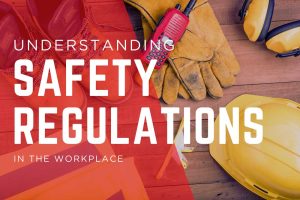Safety regulations exist so that everyone can feel safe and secure in the workplace. They introduce a shared standard that ensures hazards are identified and addressed before a problem develops into a tragedy. They govern everything from how machines are maintained, to how chemicals are stored and how people are trained to spot risks. Without these protections, workers could face exposure to harm without knowing how to avoid it.
The cornerstone of safety regulations in the UK is the Health and Safety at Work etc. Act 1974, which sets out general duties that employers have toward employees, and employees to each other. Under this act, employers are required to provide information, training, supervision and safe systems of work. Essentially the act encourages employers to promote health and safety. Supporting this framework are a range of more specific regulations.
The Work at Height Regulations require that work done at height is planned, supervised and carried out by competent people using suitable equipment. Fire safety legislation compels employers to undertake risk assessments, escape route planning, fire detection system installations and training. There are regulations for the control of noise to protect hearing, and regulations for controlling vibration to avoid hand-arm vibration syndrome and other long-term injuries.
Electrical safety is regulated too, obliging employers to ensure that electrical systems are safe and well maintained. Similarly machinery must comply with regulations that encourage correct guarding, safe operation and regular examination. Companies that work with substances hazardous to health are required to assess risks from chemicals, dust and fumes, and implement control measures like proper storage, ventilation and PPE usage.
Manual handling regulations come into play where lifting or moving loads is involved and Display Screen Equipment regulations help protect those who use computers and screens for long periods. Other specialist regulations cover biological agents for workplaces such as laboratories or healthcare, and asbestos regulations for dealing with that material safely during construction or renovation.
The Health and Safety Executive (HSE) is the principal regulator across the UK, tasked with setting standards, issuing guidance, inspecting workplaces, investigating serious incidents and prosecuting where laws are breached. HSE publishes codes of practice and supports research into occupational health. Local authorities also play a regulatory role, particularly for lower risk workplaces where HSE has delegated powers.
Other bodies have roles in specific sectors. For instance, the Environment Agency regulates certain environmental hazards, such as chemical or pollutant discharges that can affect workplaces or nearby communities. The Care Quality Commission has responsibilities in health and social care settings for cleanliness, infection control and staff safety. Fire and Rescue Services sometimes have inspection powers regarding fire safety within buildings.
Any effort to implement safety initiatives requires good leadership and buy-in from workers. Communication plays a key role. Clear reporting mechanisms for hazards, open feedback channels and the encouragement to speak up without fear of blame all contribute to creating safer workplaces. Leadership has to demonstrate commitment. Safety cannot be treated as an add-on, but instead must be embedded into everything an organisation does. When workers see managers making safe choices, safety becomes a natural part of how they do their job.
Safety regulations exist because they save lives. By taking action, organisations can prevent injuries and illnesses, creating a better work environment for everybody. At MOHS we support employers in understanding regulations and building solutions to make workplaces safer. Learn more by contacting us today at info@mohs.co.uk or call us on 0121 601 4041 to speak to a friendly member of our team.


